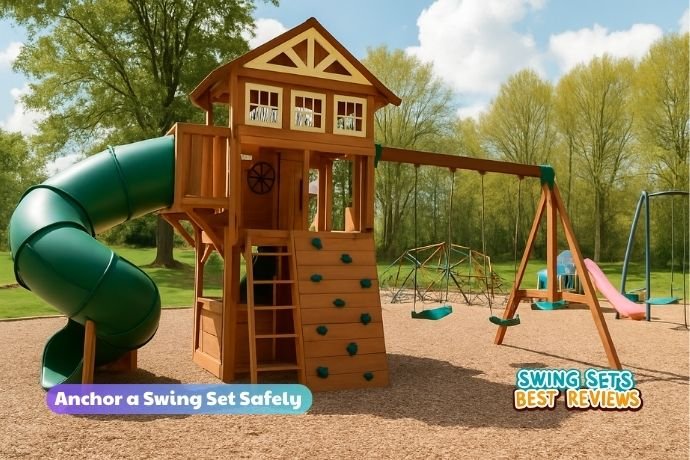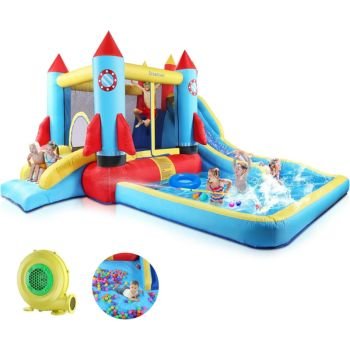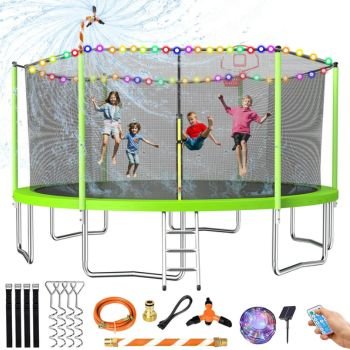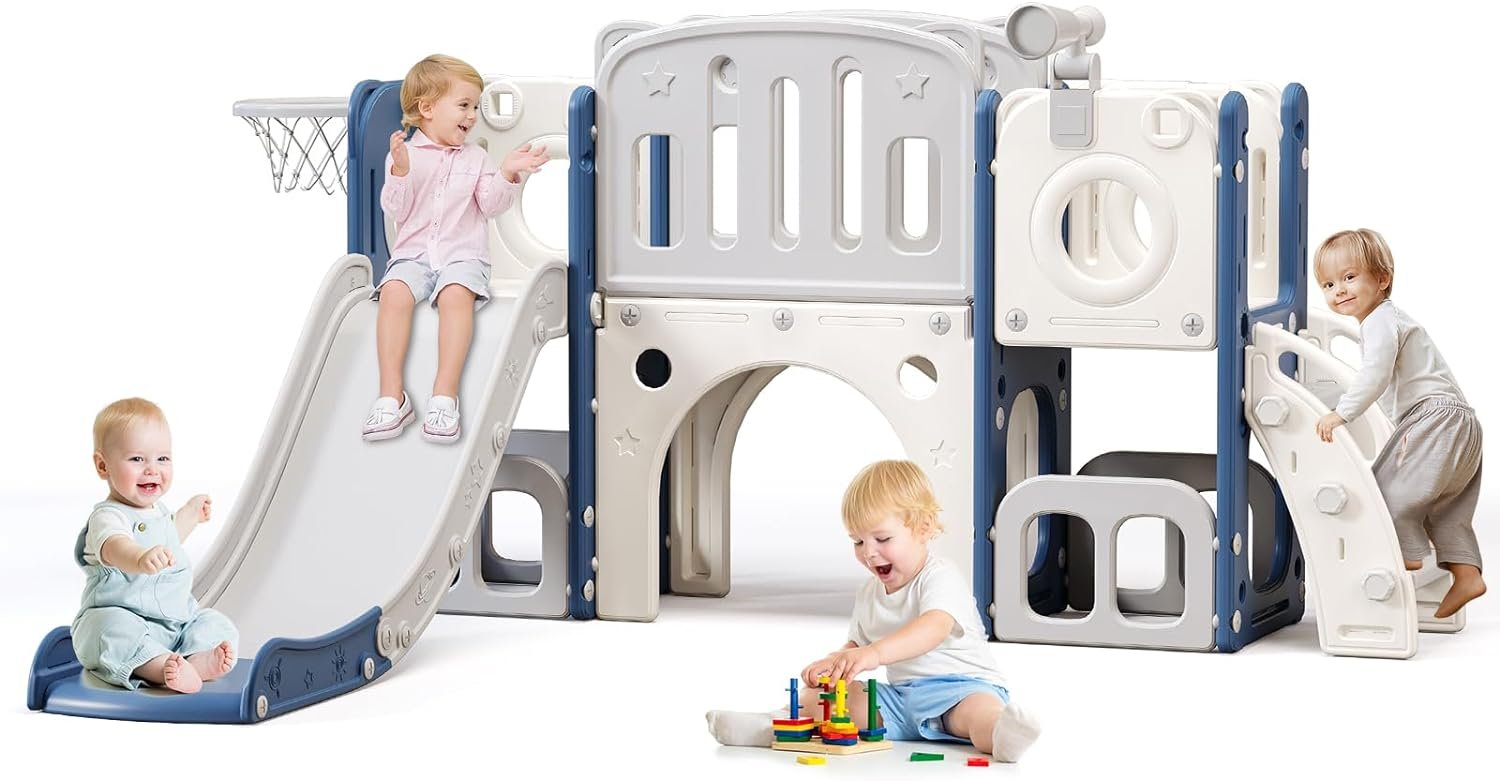So, you’ve just bought a swing set or maybe you’re planning to set one up, and now you’re wondering: how do I make sure it doesn’t tip over the first time the kids go wild on it? You’re not alone. Learning how to anchor a swing set safely is absolutely critical—not just for your peace of mind, but for your kids’ safety. Whether you’ve got a wood, metal, or plastic structure, the rules of securing it to the ground are universal: don’t cut corners.
Think about it: a poorly anchored swing set is a disaster waiting to happen. Not only can it tip over, but over time, loose bases can warp the structure, making it unsafe even if it doesn’t topple outright. From backyard barbeques to casual afternoon playdates, the swing set is often a hub of activity—and that means it needs to be rock solid.
In this article, we’re going to break it all down step by step—how to pick the right spot, what materials to use, and most importantly, the safest and most effective anchoring methods. Let’s jump into making that backyard a safe haven.
Why Proper Anchoring of a Swing Set Matters
Anchoring a swing set isn’t just a weekend project—it’s an investment in your kids’ safety and your backyard’s functionality. The structure might look stable at first glance, but without proper anchoring, it’s vulnerable to a range of risks that can easily be prevented.
Safety Considerations for Children
Let’s get real—kids don’t swing gently. They go full throttle, pushing the limits of every structure they play on. A swing set without solid anchoring is like a ticking time bomb. When that momentum builds up, every push, jump, or twist puts stress on the base. Without proper support, one wrong move could send the whole thing tipping over. Now imagine if your child or their friends were mid-swing when that happens—not a pretty picture, right?
What’s worse is the false sense of security that comes with a new swing set. It might seem stable when first assembled, but as the ground shifts and the structure loosens, so does safety. Proper anchoring ensures that even as kids grow and play rougher, the structure stays firm.
Stability During Harsh Weather Conditions
We’ve all seen it—those backyard items flung halfway across the lawn after a strong windstorm. Now picture your swing set in that scenario. A poorly anchored set can become a projectile or collapse under pressure from wind or rain-soaked soil. It’s not just about preventing tip-overs during play; anchoring protects your swing set during storms and high winds too.
Also, consider areas prone to heavy rainfall. The soil becomes soft and loses its grip on the swing set’s legs. This causes shifts that, while subtle at first, can turn into dangerous imbalances.
Longevity of the Swing Set
A securely anchored swing set lasts longer—period. Constant movement from swings and shifting bases can wear down the joints, bolts, and connections, especially if the frame wobbles even slightly. This is particularly true for wooden sets, where moisture and instability can lead to cracking and splintering.
Anchoring protects your investment. It ensures all those nuts, bolts, and beams work together as intended without excess stress. Plus, it helps preserve your lawn by preventing digging and movement around the swing set base.
✅ Related Articles
- Metal vs Wooden Swing Sets: Which is Better for Kids?
- DIY Swing Set vs Store-Bought: Pros and Cons for Families
- 10 Best Heavy-Duty Swing Sets for Older Kids | Tested
- 2026’s Best Swing Sets for Kids | Top 10 Picks Parents Love
Understanding Different Types of Swing Sets
Before diving into the actual anchoring process, you need to know what you’re working with. Not all swing sets are created equal—and the way you anchor them will depend heavily on the material and design. Let’s look at the three most common types.
Wooden Swing Sets
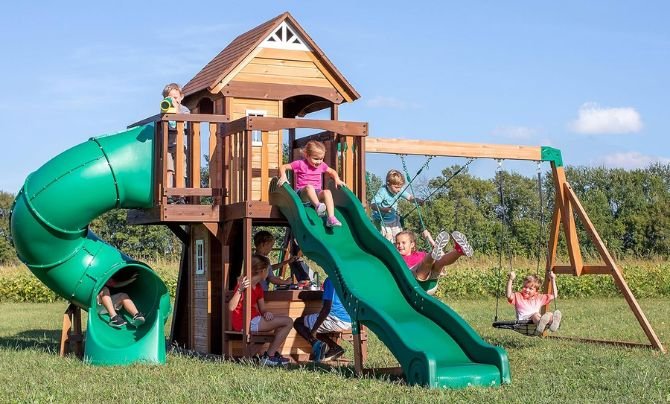
Wooden swing sets are the classic go-to for many families. They’re sturdy, attractive, and tend to blend beautifully with backyard aesthetics. But they’re also heavier, and this weight makes them appear more stable than they actually are. Don’t be fooled—a heavy wooden set still needs secure anchoring.
The tricky part with wood is moisture. If the set isn’t anchored well and begins to shift, cracks can form. Anchoring with concrete is highly recommended here, especially for long-term stability. Also, wood can warp over time, so anchoring helps reduce that risk by limiting unnecessary movement.
Metal Swing Sets
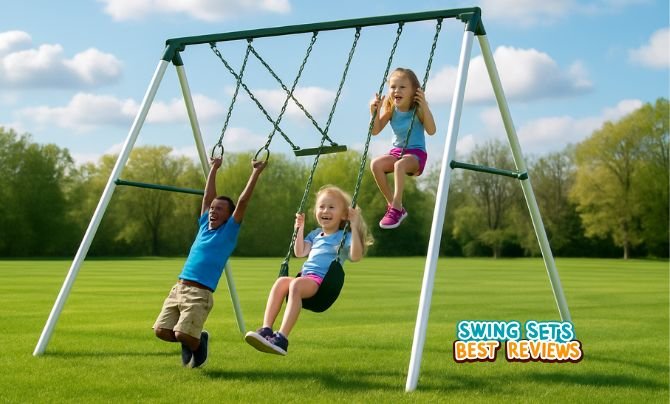
These are often lighter, cheaper, and quicker to assemble. Because of their lighter frame, metal sets are more vulnerable to tipping—especially during vigorous play or strong winds. That makes anchoring even more essential.
Metal sets usually come with built-in anchor points or recommend specific anchoring kits. These often involve screw-in ground anchors that can be installed without concrete—but depending on your local soil conditions, you might still need to reinforce with concrete for peace of mind.
Plastic or Composite Swing Sets
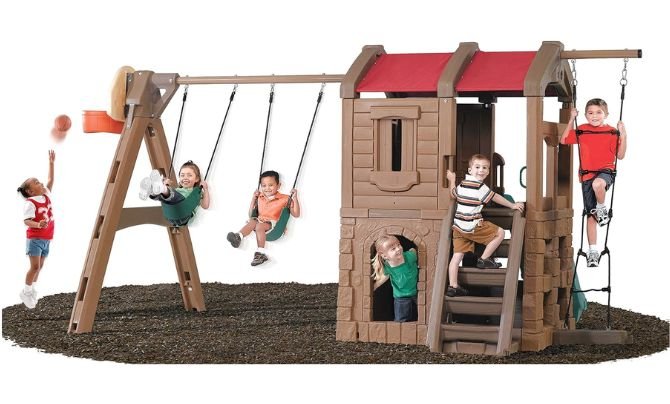
Ideal for toddlers or smaller children, plastic sets are lightweight and often portable. But they are also the least stable by nature. While you might not need industrial-strength anchoring for these, don’t skip the process entirely. Lightweight doesn’t mean no risk—especially if placed on uneven or soft ground.
Simple ground anchors or even sandbags may suffice, but always evaluate how active your kids are and the kind of terrain you’re placing the swing set on.
Choosing the Right Location in Your Backyard
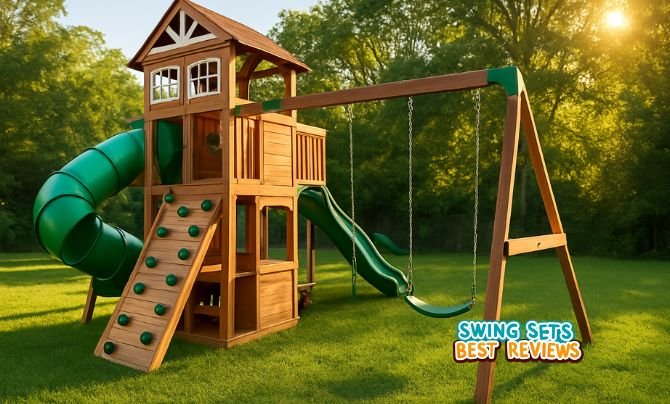
Picking a location might sound like a simple decision—just put it where there’s space, right? Not so fast. The area where you install your swing set has a massive impact on how well it can be anchored—and how safe it will be for your kids.
Level Ground vs. Sloped Surfaces
This one’s non-negotiable: flat ground is ideal. Trying to anchor a swing set on a slope is like building a house on sand. The swing won’t function correctly, the structure will lean, and the forces during play could make it even more unstable.
If your only option is sloped ground, you’ll need to do extra groundwork—literally. That means digging to level the area or using additional concrete support to create a stable foundation.
Proximity to Obstacles and Hazards
Avoid installing your swing set too close to trees, fences, decks, or concrete patios. Kids will swing high and wide—you want at least 6 feet of clearance in all directions. That not only helps prevent collisions but also gives you enough room to work with tools and materials during the anchoring process.
Watch out for underground hazards too—sprinkler lines, septic tanks, or utility pipes. You don’t want to dig into those while installing anchors.
Accessibility and Visibility
Your swing set should be visible from the main areas of the house—kitchen windows, patio, etc. This helps you keep an eye on the kids while you’re indoors. Accessibility also matters for maintenance. Don’t tuck the set in a hard-to-reach corner where you can’t inspect anchors or bolts regularly.
Tools and Materials You’ll Need to Anchor a Swing Set
Before you start anchoring, gather everything you’ll need. Having the right tools and materials on hand will save you time, reduce frustration, and ensure a smoother (and safer) installation process.
Ground Anchors: Types and Uses
There are a few types of ground anchors to consider:
- Screw-in anchors (auger style): Twist into the ground with a handle. Great for most soil types.
- Concrete anchors: Use with wet cement to permanently fix posts in place.
- Strap-based anchors: Come with metal stakes and tension straps—easier to install but less durable.
- Bolt-down anchors: Often used for pre-made swing sets with anchor plates.
Pick the anchor based on your soil, swing set material, and desired permanence.
Tools for Digging and Measuring
- Post hole digger or shovel (for concrete anchors)
- Drill with masonry or wood bits
- Level (to ensure the set is even)
- Tape measure
- Wrench or socket set
Concrete and Other Reinforcement Materials
If you’re going the concrete route:
- Quick-set concrete mix (one bag per anchor hole)
- Water source (hose or buckets)
- Mixing tub or wheelbarrow
- Stakes and string for alignment
Methods to Anchor a Swing Set Safely
Once you’ve chosen the right spot and gathered your tools, it’s time to anchor the swing set. There are several methods you can use, and the best choice depends on your swing set’s material, the soil type, and whether you want a permanent or temporary installation.
Using Ground Anchors (Screw-in or Auger Style)
Screw-in or auger-style ground anchors are among the most common and user-friendly options. They’re perfect for most soil types and don’t require concrete, making them ideal for those who might need to relocate the swing set in the future.
Step-by-step process:
- Position the swing set: Assemble the set and place it in the chosen location. Ensure it’s level.
- Mark anchor spots: Most swing sets have pre-drilled holes in the legs or base. Use a pencil or chalk to mark the exact location where the anchors will go.
- Insert the auger: Twist the anchor into the ground at each marked point. You may need a rod or pipe to use as leverage through the anchor’s loop. Make sure the anchor goes deep—at least 12 to 18 inches for good grip.
- Secure the frame: Use heavy-duty bolts or straps to attach the anchor to the swing set legs. Tighten all fasteners firmly.
Pros:
- No concrete needed
- Easier and quicker to install
- Removable for repositioning
Cons:
- May not hold as well in sandy or loose soil
- Not as secure as concrete for very active use
Tip: Always double-check tightness after the first few uses. Ground anchors can loosen slightly as the soil settles.
Anchoring with Concrete for Permanent Stability
Concrete anchors are ideal for homeowners who want to create a long-term, super-stable installation. This method is highly recommended for wooden or heavy metal sets where safety is the top priority.
Step-by-step process:
- Dig the holes: Use a post hole digger to create holes at each leg—about 12 to 18 inches deep and 8 inches wide.
- Prepare the frame: If your swing set has anchor brackets, align them above the holes.
- Mix and pour concrete: Follow the instructions on the quick-set concrete bag. Pour the mixture into the hole while keeping the swing set leg in place.
- Level and cure: Use a level to ensure the swing set remains straight. Let the concrete cure for at least 24-48 hours before using the swing.
Pros:
- Most secure option
- Withstands rough play and harsh weather
- Extremely long-lasting
Cons:
- Not movable
- More labor-intensive
- Requires drying time
Tip: For extra support, embed a metal bracket or rebar into the concrete to create a stronger grip around the swing set legs.
Hybrid Methods for Maximum Safety
Some homeowners opt for a hybrid method—using both screw-in anchors and a small concrete footing. This approach offers added stability without the permanence of a fully concrete base.
For example, you can install auger-style anchors, then pour a small amount of concrete at the base of each leg to reinforce the soil and secure the anchor further. This is particularly useful in areas with soft or sandy soil where anchors alone might not hold.
Testing the Anchoring System for Swing Set Safety
So, you’ve installed the anchors and secured your swing set—nice work! But you’re not done yet. Before the kids can hop on and start swinging, it’s time for a safety test. Testing your anchoring system ensures everything is locked in and ready to handle real-world use.
Initial Stability Check
Start by giving your swing set a firm shake from different angles. Push it forward, backward, and side to side. You’re testing whether the legs shift or the anchors wiggle under pressure. If there’s noticeable movement, something’s off. Check all anchor connections and re-tighten bolts if necessary.
Don’t forget to inspect the frame, too. Even if the base is solid, joints and connecting parts might need reinforcement. Look for wobbles, creaks, or any signs of stress at the bolts and nuts.
Weight Testing and Simulated Play
Before kids start swinging high, do a “dry run.” Hang some weights (like sandbags) on each swing or have an adult gently test it out. Observe how the frame reacts to the motion. A properly anchored swing set should remain absolutely still at the base—no tilting, no rising legs, no shifting sounds.
Gradually increase the pressure: simulate back-and-forth swinging, side-to-side motion, and dismounting. Every swing direction puts different stress on the anchors.
Inspection After First Week of Use
After a week of real play, do a full inspection. Soil can settle, especially if it rained, which may cause anchors to loosen. Re-tighten bolts, inspect concrete (if used), and confirm that all straps or brackets are holding as expected.
Pro tip: Make this part of a monthly routine. Regular checks can catch problems early and prevent accidents before they happen.
👉 You Might Be Interested In
- Best Outdoor Climbing Toys for Kids Under 5
- 10 Best Budget Swing Sets Under $500 That Parents Love
- Premium Wooden Swing Sets | The Ultimate Backyard Upgrade in 2026
- Best Indoor Playsets for Kids in 2026 | Safe, Affordable
- 10 Must-Have Playsets for Kids | Perfect for Small Backyards & Limited Spaces
- 10 Best Toddler Swing Sets for Indoor & Outdoor Fun
Common Mistakes to Avoid When Anchoring a Swing Set
Anchoring a swing set might seem like a basic DIY job, but many homeowners make avoidable mistakes that can lead to safety issues down the line. Here are some common pitfalls and how to sidestep them.
Ignoring Soil Conditions
One of the biggest mistakes is assuming all soil types hold anchors equally. Sandy or clay-heavy soil won’t grip auger-style anchors as well as loamy soil. In these cases, skipping concrete reinforcement is a gamble. Always test soil stability first, or you might end up with a swing set that shifts after a rainstorm or two.
Incorrect Anchor Type for Swing Set Material
Different swing sets need different anchoring methods. Using strap-based anchors on a heavy wooden frame? That’s a recipe for movement. Likewise, pouring concrete around a lightweight plastic frame might be overkill—and unnecessary. Match the anchoring method to your swing set’s material and weight.
Failing to Level the Set Before Anchoring
This is surprisingly common. If you anchor a swing set before leveling it properly, you’re locking in that tilt forever—especially with concrete. An unlevel swing set leads to uneven wear, swinging issues, and possible tipping over time.
Always use a carpenter’s level during setup. Adjust the legs or dig shallow trenches to ensure everything is flat and balanced before anchoring.
Not Tightening Fasteners Enough
Loose bolts and brackets are a slow-building problem. Even with good anchors, if the fasteners aren’t secure, the frame can shift over time. Use a torque wrench if possible and tighten all bolts to manufacturer specs. And again—routine checks are key.
Maintaining the Safety of Your Anchored Swing Set
Congratulations, you’ve anchored your swing set! But safe play doesn’t end with installation. Just like a car or a bike, a swing set needs ongoing maintenance to stay secure and functional for years to come.
Monthly Inspection Checklist
Set a reminder on your phone—once a month, do a quick safety sweep:
- Check anchor points: Are the anchors still flush with the ground? Are any bolts or straps loose?
- Inspect the frame: Look for rust (on metal), cracks (on wood), or UV damage (on plastic).
- Look at the ground: Is the soil eroding around the base? Any signs of movement or sinking?
A five-minute inspection can prevent a costly or dangerous accident.
Tighten and Lubricate Hardware
Over time, bolts can loosen from play vibrations. Use a socket wrench to re-tighten all connection points every few months. For metal parts, apply a weather-resistant lubricant to prevent rust and squeaking.
Watch the Weather
After major storms, always check your swing set—even if you used concrete anchors. Strong winds or waterlogged ground can shift or damage anchors. Reinforce or reset them as needed.
Pro tip: Cover your swing set in winter or during long periods of non-use. This protects it from weather wear and minimizes maintenance.
When to Re-anchor or Replace Your System
Sometimes, even the best anchoring job can’t stand the test of time. Whether it’s wear and tear, poor installation, or just changing backyard conditions, there comes a time when you’ll need to re-anchor—or even replace—the swing set.
Signs You Need to Re-anchor
- Swing set rocks or shifts during play
- Anchors appear above ground or are loose
- Concrete footings show cracks or signs of erosion
- Soil around the legs is compacted or washed out
Don’t wait until something breaks. Re-anchoring is easier than fixing a major injury or a collapsed frame.
Upgrading to a More Secure Method
Maybe you started with screw-in anchors but your kids grew older—and more daring. If the swing set now sees heavier use, consider upgrading to a concrete base or hybrid anchoring system for added stability.
Cost and Time Estimate to Anchor a Swing Set
Wondering what you’ll need to budget for this project? Here’s a general breakdown:
| Item | Estimated Cost |
|---|---|
| Ground anchors (4-pack) | $20 – $50 |
| Quick-set concrete (4 bags) | $25 – $40 |
| Tools (if not already owned) | $30 – $100 |
| Total DIY Time | 2 – 4 hours |
| Professional Installation | $150 – $400 |
It’s a manageable weekend project for most people, especially with basic tools already on hand.
Conclusion
Installing a swing set in your backyard is a wonderful investment in fun, creativity, and outdoor time for your kids. But the key to enjoying all those benefits? Learning how to anchor a swing set safely—and doing it right the first time. Whether you go with screw-in ground anchors, a concrete base, or a hybrid approach, what matters most is stability, safety, and peace of mind.
Take the time to inspect, maintain, and upgrade as needed. Your kids will swing higher and laugh louder knowing they’re playing on a rock-solid structure—and you’ll rest easier knowing they’re safe.
FAQs
1. Can I anchor a swing set without using concrete?
Yes, many swing sets can be anchored using screw-in ground anchors or stake-based systems. However, for maximum stability, especially in loose soil, concrete is recommended.
2. How deep should the anchors go into the ground?
For ground anchors, aim for 12 to 18 inches deep. If you’re using concrete, dig holes that are at least 12 inches wide and 18 inches deep for optimal strength.
3. Is it safe to place a swing set on artificial turf?
Yes, but you need to anchor through the turf into the soil or concrete below. Artificial turf alone doesn’t provide anchoring stability.
4. How often should I inspect my swing set anchors?
Ideally, once a month. Also inspect after major storms, heavy play, or changes in the soil.
5. What’s the best anchoring method for a sloped backyard?
In sloped areas, you’ll likely need to level the ground and use concrete anchors. Auger anchors might not hold well unless the soil is firm and compact.



